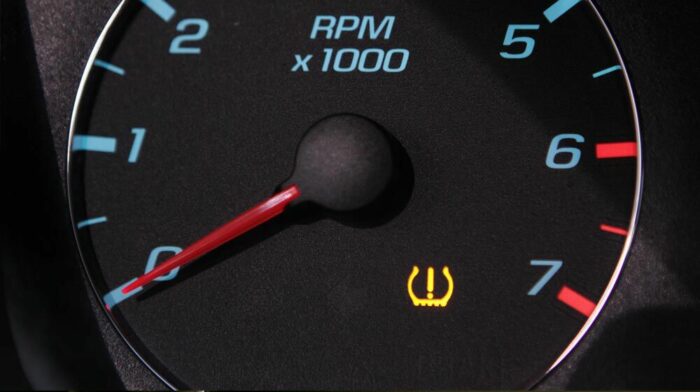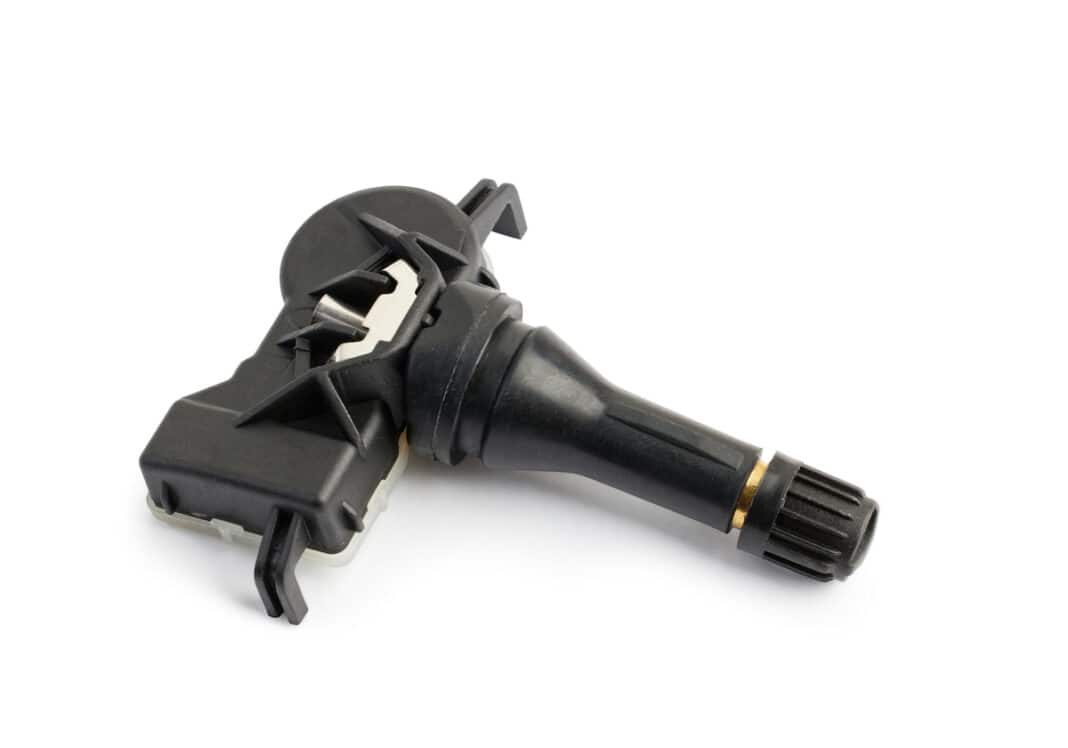In this guide, we cover:
- How the TPMS works (and the two types of sensors to know about)
- How to reset the sensor system
- Why these systems should be a last resort
- Finally, why low tire pressure matters in the first place

How your vehicle’s Tire Pressure Monitoring System (TPMS) works
Generally speaking, they work by using a sensor inside the tire, mounted on the wheel, that tracks pressure and sends a signal by radio to the car’s control unit. Because tire pressures typically fluctuate during driving, particularly as the tires heat up, these aren’t the most sensitive sensors you can find. After all, you don’t want the sensors going off for just nothing, right?
There are two main types of TPMS sensors: direct and indirect.
Direct TPMS:
Direct TPMS sensors use a battery to power the sensor and RF transmitter. The sensor constantly measures tire pressure and sends this information to the vehicle’s computer. If the pressure decreases significantly, the TPMS system sends a warning to the driver.
- Sensor Location: Direct TPMS sensors are installed inside each tire and wheel assembly.
- Pressure Measurement: These sensors directly measure the air pressure within the tire.
- Communication: They use radio frequency (RF) signals to transmit data wirelessly to the vehicle’s onboard computer.
- Alerts: When the pressure drops below the recommended threshold, the TPMS alerts the driver through a warning light on the instrument cluster.
Indirect TPMS:
In both cases, the TPMS system is designed to enhance safety by warning drivers of underinflated tires, which can lead to reduced handling, reduced fuel efficiency, and increased risk of tire failure. Properly inflated tires are essential for safe and efficient driving, which is why TPMS systems have become a standard feature in modern vehicles.
- Sensor Location: Indirect TPMS doesn’t use individual sensors inside the tires.
- Pressure Measurement: Instead, it relies on data from the vehicle’s anti-lock brake system (ABS) to estimate tire pressure.
- Communication: There is no direct communication between sensors and the onboard computer. Indirect TPMS compares the rotational speed of each wheel to detect differences.
- Alerts: If it detects a significant difference in wheel speeds, it assumes that one or more tires may be underinflated and triggers a warning.
How to reset the tire pressure sensor
Resetting the system once you’ve found the low tire and inflated it properly varies from vehicle to vehicle, so check your owner’s manual. If you see a button with an illustration of a cross-section of a tire, that’s more than likely it. Here’s a quick step-by-step for most vehicles:
1. Ensure that your tires are correctly inflated to the recommended pressure. You can find this information in your vehicle’s owner’s manual or a placard inside the driver’s side door jamb.
2. Start your vehicle and ensure it’s in Park or Neutral, with the parking brake engaged.
3. Locate the TPMS reset button, usually found under the steering column. The button may also be labeled as “TPMS,” “Tire Pressure,” or have an icon resembling a tire with an exclamation point.
4. Press and hold the TPMS reset button until you see a warning light on the instrument cluster. This light may look like a tire with an exclamation point or the letters “TPMS.”
5. Continue holding the button until the warning light blinks or turns off. This process typically takes about 5-10 seconds.
6. Release the TPMS reset button.
7. Turn off the vehicle and start it again.
8. Drive your vehicle for a few miles at a speed of at least 30 mph (48 km/h). This will allow the TPMS to recalibrate.
9. Check the tire pressure monitor system to ensure that the tire pressure warning light has turned off.
Tire pressure sensors are a last resort!
As we mentioned, tire pressures typically fluctuate during driving, mainly as the tires heat up; thus, these aren’t the most sensitive sensors you can find.
The trick is to keep checking your tires even when your new car has a fancy tire pressure system.
That means you have to treat the tire pressure monitoring system as a last-resort warning rather than assuming the lack of a warning means all is well. Some systems don’t go off until the pressure is as much as 25 percent down.
That’s dangerously low, so the trick is to keep checking your tires even when your new car has a fancy tire pressure system.
But when that low-pressure indicator does light up, don’t freak out. The culprit could be a number of things, including falling temperatures.
Common reasons why a low-pressure indicator might light up (other than low tire pressure)
Temperature Changes: Tire pressure is affected by temperature. Colder weather can cause the air inside the tires to contract, leading to lower pressure. Similarly, hot weather can cause the air to expand, increasing tire pressure. Seasonal fluctuations may trigger TPMS warnings.
Tire Damage: Punctures, cuts, or damage to the tire’s sidewall can lead to slow leaks. If a tire gradually loses pressure, it can trigger the TPMS.
Faulty Sensors: TPMS sensors can occasionally malfunction or fail, leading to inaccurate readings. This is more common in older vehicles.
Battery Issues: Some TPMS sensors use batteries to operate. When these batteries die, the sensors can fail, leading to a TPMS warning.
Sensor Placement: If the sensors are not properly installed or placed incorrectly during tire replacement or maintenance, they may not function as intended.
Calibration: After tire rotation or replacement, some TPMS systems need to be recalibrated to recognize the new positions of each tire. If this isn’t done correctly, it can trigger false warnings.
Interference: Sometimes, radio frequency interference or electronic devices near the sensors can disrupt the TPMS signals.
TPMS Reset: If you’ve adjusted the tire pressure to the correct levels and the TPMS warning persists, you may need to reset the system as per your vehicle’s manual.
TPMS Software Updates: Some vehicles may require software updates for the TPMS system. If the software is outdated, it can lead to inaccurate readings.
Why low tire pressure matters in the first place
Tires with less than desirable pressure create uneven wear, leading to sidewall-killing heat that turns your vehicle’s handling to mush – and that’s obviously not good, especially for more expensive rubber such as high-performance tires.
But too much pressure is equally harmful, creating uneven wear and leading to inadequate handling or, worse, a tire blowout.
Low pressure allows the sidewalls to flex too much, generating heat, and it also increases the odds of wheel damage when you hit a pothole. The softer sidewalls are more likely to crush on impact to the point your wheel takes a hit.
It also turns the rolling surface concave, putting more wear on the treads on the sides than on the centre. Because the tires are flexing so much, your handling suffers, too.
Too much pressure turns the rolling surface convex, putting more wear on the centre treads than the sides, and because it’s riding on the centre instead of the entire tread, you don’t get the turning power or traction you should.
Takeaway
We love new tech, and the latest vehicles are full of it. Perhaps, a bit too much, some would say. But innovative technologies like built-in tire pressure sensor warning systems serve to make our lives easier and safer on the roads, allowing drivers to be prepared before a full-out tire blowout occurs, for instance. Too much or too little tire pressure isn’t desirable and can lead to an accident.
But that said, being too reliant on new technology may also cause problems. A TPMS is certainly helpful, but it shouldn’t be used as your first go-to indicator for low tire pressure; there are too many other reasons for a false warning. So, regularly (and manually) checking your vehicle’s tire pressure is the correct way forward.


